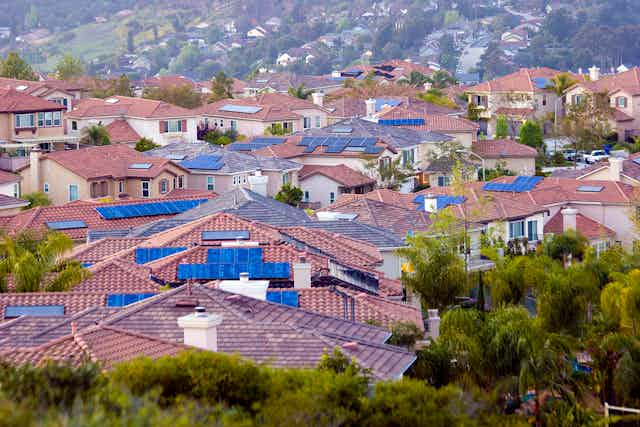Contrary to expectations, demand for electricity in Australia has been falling for several years. Reasons for this include large price rises (of which the carbon price is a relatively small component), improved home insulation and appliance efficiency, subdued manufacturing, and the rise of rooftop photovoltaic systems (the output from which is not included in demand figures).
Falling demand is placing pressure on the business models of the electricity industry. The potential for the installation of tens of thousands of megawatts of cost-effective rooftop PV systems places severe additional pressure on business models.
The cost of generating electricity from roof-mounted solar photovoltaic panels has fallen far below the retail tariff for both domestic and business customers everywhere in Australia, and is projected to fall further. The simple payback time for a domestic PV system is about five years in Adelaide, seven to eight years in Perth, Melbourne, Brisbane and Sydney, and ten years in Canberra and Hobart. The expected life of a PV system is 25 years.
Large businesses that primarily use electricity during business hours self-consume most of the electricity produced by PV systems on their own rooftops. However, small businesses and house owners rely on the grid to balance the supply of electricity from their rooftop PV system with their own demand. Only rarely would PV production balance with electricity demand within the building.
So a fair and reasonable price needs to be struck for electricity fed into the grid from rooftop PV systems.
The PV industry advocates a 1:1 relationship between the price paid by utilities for electricity fed into the grid by rooftop PV systems and electricity purchased from the utilities. However, some states are allowing utilities to pay very low prices for fed-in PV electricity.
It is widely recognised that electricity providers have over-spent on equipment to meet peak electricity demand. It would be better to manage rather than meet this peak demand.
Cost-reflective retail tariffs are one way to moderate electricity use during times of peak demand. But time-of-use price signals in the wholesale market are muted in the retail market: flat tariffs are more prevalent.
Introducing retail time-of-use tariffs would allow the true value of electricity from roof-mounted PV systems to emerge - particularly in meeting weekday daytime business loads and air-conditioning loads, both of which are well-correlated with PV-availability.
Should state governments and utilities persist in offering very low PV feed-in tariffs, perverse outcomes may result.
If the PV feed-in tariff is below the domestic off-peak tariff (now a common situation in the eastern states) it makes sense for PV owners not to put their power back into the grid. Instead, excess electricity from a domestic rooftop PV system should be used to make hot water in a conventional resistance-heated storage tank. Using PV electricity this way is now competitive with hot water supply from domestic off-peak (night-time) electric, conventional solar and gas hot water heating systems.
However, given electricity is much more useful than heat, from a national perspective this is a poor use of solar electricity.
Another example of a perverse outcome is that battery storage systems, in conjunction with PV systems, are economic in competition with domestic retail tariffs in most Australian capital cities. Batteries allow smoothing of PV system output, storing power when generation is high and releasing it when it’s low. This leads to much higher self-consumption of PV electricity and avoids unrealistically low PV feed-in tariffs.
For example, using current battery and PV system prices, a Sydneysider could store half the electricity generated each day in well-maintained lead-acid batteries, for use in the evening and early morning, and the result would be very economic.
However, domestic battery storage comes with risks. Maintaining and disposing of batteries requires technical skill and care.
This approach illustrates the absurdity of offering PV feed-in tariffs far below 15 c/kWh when the domestic electricity tariff is 20-35 c/kWh. If electricity storage at the domestic level is cost effective, then it must be far more cost effective to do it at suburban, city or state level. At this scale, we could use much larger and lower-cost storage techniques, including industrial-scale batteries, compressed air, flywheels and pumped hydro. Demand management - through switching optional loads on and off to balance supply and demand - is cheaper still.
In order to avoid the perverse outcomes mentioned above, we need reasonable PV feed in tariffs in the range of 15 c/kWh. These should be established in conjunction with demand management, retail time-of-use tariffs and increased use of storage.
This will allow rooftop PV systems to contribute substantially to continued falls in electricity consumption with associated reductions in greenhouse gas emissions.

